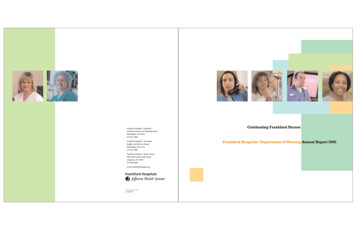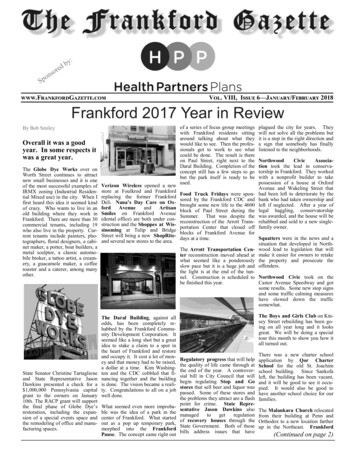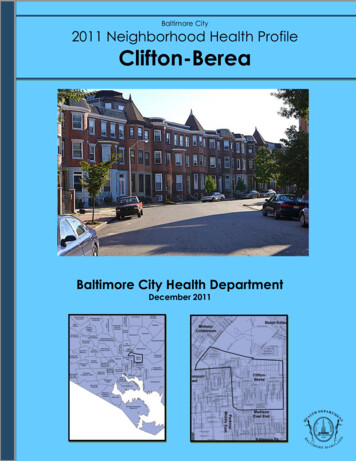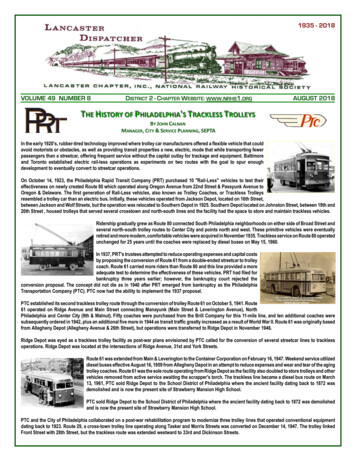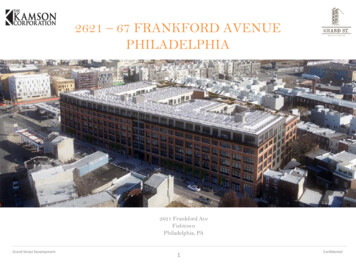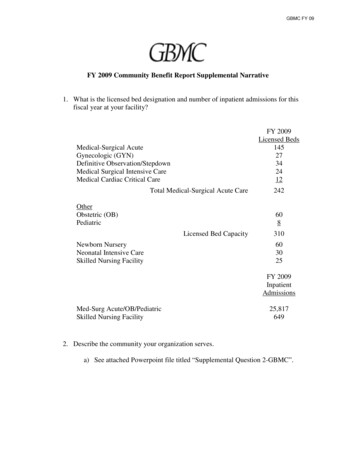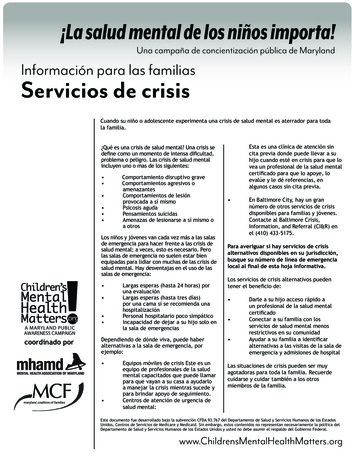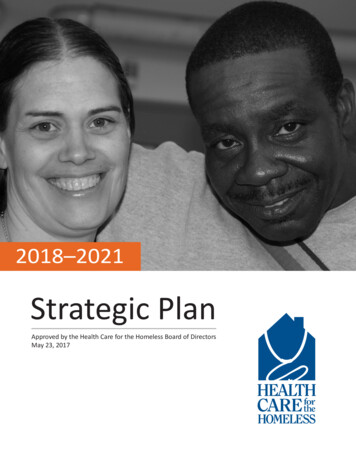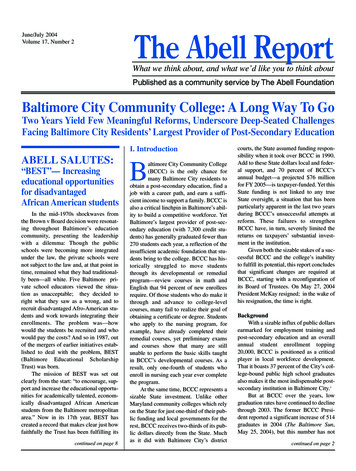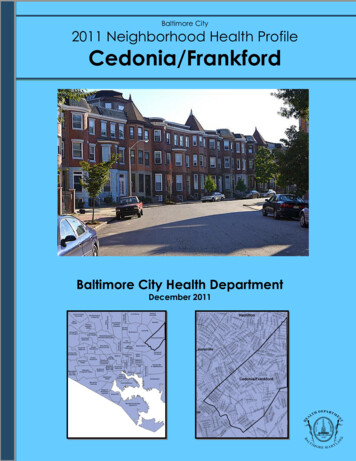
Transcription
Baltimore City2011 Neighborhood Health ProfileCedonia/FrankfordBaltimore City Health DepartmentDecember 20111Cedonia/Frankford
Table of Contents1. Introduction .22. Demographics .33. Socioeconomic Characteristics .44. Education .55. Community Built and Social Environment .66. Housing .87. Food Environment .98. Health Outcomes .109. Neighborhood Summary .1410. Technical Notes .16AuthorsOffice of Policy and PlanningAlisa Ames, MHSMark EvansLaura Fox, MPHAdam J. Milam, MHSRyan J. Petteway, MPHRegina Rutledge, MPHAcknowledgementsThis report was developed by Ryan Petteway, Alisa Ames, and Caroline Fichtenberg of the Baltimore CityHealth Department with the assistance of Nicole Robinson, a master’s geography student at UMD. Thereport was completed by Mark Evans, Adam Milam, Regina Rutledge, and Laura Fox. The authors wouldlike to thank the following individuals and organizations for providing data and/or contributing analyses:Matthew Kachura of the Baltimore Neighborhood Indicators Alliance, Anne Palmer and Amanda Behrensof the Johns Hopkins Center for a Livable Future, Jeanetta Churchill of Baltimore City Public Schools, theBaltimore Police Department, the Maryland Department of the Environment, Robert Hayman, Dr.Isabelle Horon, Hal Sommers of Maryland Vital Statistic Administration, Travis Pate of the Baltimore CityPlanning Department, and Mark Dennis of the Mayor’s Office.Suggested citationAmes, A., Evans, M., Fox, L., Milam, A., Petteway, R., Rutledge, R. 2011 Neighborhood Health Profile:Cedonia/Frankford. Baltimore City Health Department, December 2011Electronic SourceThis report is available at edonia/Frankford
IntroductionIn the fall of 2008, the Baltimore City Health Department released its first iteration of theNeighborhood Health Profiles. The 2008 Profiles were developed in an effort to provideresidents information regarding the health status of their specific communities, as well as tofacilitate identification of priority health areas and inspire collaborative action. These Profilesrevealed stark inequities in health outcomes between our City’s neighborhoods. The mostharrowing of these inequities was a 20 year gap in life expectancy between two neighborhoodsthat are less than five miles apart.The new 2011 Neighborhood Health Profiles build on the 2008 Profiles by looking at theunderlying factors that affect health in each neighborhood—the social determinants of health.The social determinants of health are the conditions in which residents live, learn, work, andplay, and include factors like access to healthy food, healthy housing, quality schools, and safeplaces to be active. According to the world’s leading public health authority, the World HealthOrganization, “The social determinants of health are mostly responsible for health inequities.”The 2011 Profiles will thus allow residents to not only identify priority health issues, but also toidentify underlying conditions that are more immediately actionable. Residents are presentedwith data on lung cancer mortality, for example, as well as data on tobacco retail density.Each 2011 Neighborhood Health Profile is divided into 10 sections. The first section provides anoverview of demographic information—the total population, age, gender, and race andethnicity of neighborhood residents. Sections Two through Six provide data on the socialdeterminants of health by neighborhood—the conditions in which residents live, learn, work,and play that affect health. These include data on: socioeconomic factors, education, thecommunity built and social environment, housing, and the food environment. The seventhsection provides data on health outcomes, including data on life expectancy, mortality andcauses of death, and maternal and child health outcomes. The eighth section summarizes howeach neighborhood compares to the other neighborhoods for the social determinants of healthindicators. The ninth section summarizes how each neighborhood compares to the otherneighborhoods for health outcomes. Technical notes in section ten provide details on how thedata were collected and tabulated. In this report, the terms “neighborhood” and “CommunityStatistical Area” are used interchangeably.The 2011 Neighborhood Health Profiles provide Baltimore citizens with objective data thataccurately reflect local health issues. They clearly illustrate that neighborhoods have distincthealth issues that must be addressed with full participation of affected communities. The 2011Profiles can help communities shift how they think about health to incorporate a robustspectrum of the social determinants of health. They are intended to be used in conjunctionwith Healthy Baltimore 2015, the city’s health policy agenda. Healthy Baltimore 2015 outlinesthe health priorities that account for the greatest amount of preventable disease, disability anddeath in Baltimore city. The 2011 Profiles move us in our growing efforts to eliminate healthinequities and achieve health equity for all Baltimore communities.2Cedonia/Frankford
1. DemographicsNeighborhood: Cedonia/Frankford at a GlanceTotal population in Baltimore City in 2010Total population in Cedonia/Frankford in 2010616,80223,557AgeThe age distribution of Cedonia/Frankford compared to Baltimore City overall (2010).Cedonia/FrankfordBaltimore City0-17 years24.5%21.6%18-24 years11.6%12.5%25-44 years27.5%28.8%45-64 years27.8%25.2%65 years8.7%11.8%Source: 2010 US Census.GenderThe percent of men and women in Cedonia/Frankford compared to Baltimore City overall (2010).Cedonia/FrankfordBaltimore CityMen45.8%46.7%Women54.2%53.3%Source: 2010 US Census.Race/EthnicityThe race and ethnicity distribution of Cedonia/Frankford compared to Baltimore City overall (2010).Cedonia/FrankfordBaltimore CityBlack or African American79.1%63.6%White15.6%29.7%Asian2.3%2.4%Some Other Race10.9%2.2%Two or More Races2.1%2.1%Hispanic or Latino22.0%4.2%1Hispanic or Latino ethnicity overlaps with other race categories.Some other race includes American Indian or Alaska Native, Native Hawaiian or Other Pacific Islander, and choosing other races as an optionon the census.Source: 2010 US Census.23Cedonia/Frankford
2. Socioeconomic CharacteristicsMedian Household IncomeThe household income distribution of Cedonia/Frankford compared to Baltimore City overall (2010).Cedonia/FrankfordBaltimore City 38,144 37,395Less than 25,00028.4%33.3% 25,000- 39,99923.4%18.1% 40,000- 59,99921.5%17.1% 60,000- 74,99911.4%9.1% 75,000 and over15.4%22.5%Median Household IncomeSource: American Community Survey, 2005-2009.UnemploymentThe percent of the Cedonia/Frankford population 16 years of age and older that are unemployed in thecivilian labor force.Cedonia/FrankfordBaltimore City10.7%11.1%Percent UnemployedSource: American Community Survey, 2005-2009.Family Poverty RateThe percent of families in Cedonia/Frankford that have an income below the poverty level compared toBaltimore City overall (2010).Cedonia/FrankfordBaltimore City12.5%15.2%Percent of Families in PovertySource: American Community Survey, 2005-2009.Percent of Single-Parent HouseholdsThe percent of households with children 18 years in Cedonia/Frankford. The denominators are basedon the number of families in each CSA (2010).Percent of Single-ParentHouseholdsCedonia/FrankfordBaltimore City29.2%26.0%Source: 2010 US Census.4Cedonia/Frankford
3. EducationEducational attainment is one of the most critical determinants of health around the world. The WorldHealth Organization has indicated that the single most important step in improving health andeliminating health inequities is making a greater investment in early childhood development andensuring that all children can attain their full education potential. In Baltimore, many of the largestdocumented health inequities are between residents with differing levels of educational attainment. Forexample, residents with only a high school education or less have an all-cause death rate that is almostthree times higher than that for residents with a bachelor’s degree or higher. Ensuring all residents canachieve their full education potential is essential to efforts to improve community health and eliminatehealth inequities.School Readiness and 3rd and 8th Grade Reading ProficiencyThe percent of kindergartners assessed as “fully ready” in Cedonia/Frankford compared to BaltimoreCity overall (in school years 2007-2008 and 2008-2009). The percent of 3rd and 8th graders who arereading at “Proficient or Advanced” level in Cedonia/Frankford compared to Baltimore City overall(school year 2008-2009).Percent of Kindergartners“Fully Ready” to Learn13rd Graders at “Proficient orAdvanced” Reading Level28th Graders at “Proficient orAdvanced” Reading Level212Cedonia/FrankfordBaltimore City70.5%65.0%77.6%77.6%62.0%58.6%Source: Baltimore City Public Schools-Work Sampling System (WSS) of the Maryland Model for School Readiness (MMSR).Source: Baltimore Neighborhood Indicators Alliance (BNIA) from the Baltimore City Public SchoolsSchool AbsenteeismThe percent of elementary, middle, and high school students who missed 20 or more days of school inCedonia/Frankford compared to Baltimore City overall (school year 2008-2009).Percent of Elementary SchoolStudents Missing 20 DaysPercent of Middle SchoolStudents Missing 20 DaysPercent of High SchoolStudents Missing 20 DaysCedonia/FrankfordBaltimore City10.2%10.1%9.3%16.3%32.3%39.2%Source: Baltimore Neighborhood Indicators Alliance (BNIA) from the Baltimore City Public Schools.Adult Educational AttainmentEducational attainment among residents 25 years and older in Cedonia/Frankford compared toBaltimore City overall.Percent of residents 25 yearsand older with a high schooldegree or lessPercent of residents 25 yearsand older with a bachelorsdegree or moreCedonia/FrankfordBaltimore City60.5%52.6%14.8%25.0%Source: American Community Survey, 2005-2009.5Cedonia/Frankford
4. Community Built and Social EnvironmentA neighborhood’s built environment includes its physical attributes and structures, like buildings andlots, parks and green space, streets and sidewalks, hazardous waste sites, and businesses and retailshops. The built environment affects how people use space and interact with one another and hasimpacts on health. For example, clean and safe parks and green space allow for social interaction andopportunities to be physically active, whereas dirty streets and alleys may restrict or deter engaging insuch opportunities. Having a selection of businesses and shops in a neighborhood also promotes socialinteraction and encourages more walking—things that are good for community and individual health.On the other hand, the presence of alcohol stores is strongly associated with crime and communityviolence, which deter outdoor activity and impose physical and mental health burdens.A neighborhood’s social environment includes factors related to the living, working, learning, andplaying conditions of its residents. The social environment includes social institutions (cultural andreligious institutions, economic systems, and political structures), social surroundings (workplace andschool environments), and how its residents interact with one another, as well as how they interact withand within the contexts of their social institutions and surroundings. General socioeconomic conditions,such as poverty, income, employment, and educational attainment, as well as factors like discrimination,crime, and incarceration rates all impact a neighborhood’s social environment. These elements interactto shape opportunities for individual and community health in many ways.Alcohol Store DensityThe number of alcohol stores (Class A) per 10,000 residents of Cedonia/Frankford compared toBaltimore City overall (2009).Alcohol Store DensityCedonia/FrankfordBaltimore City4.74.6Source: Baltimore City Liquor Board.Tobacco Store DensityThe number of tobacco stores per 10,000 residents of Cedonia/Frankford compared to Baltimore Cityoverall (2009).Tobacco Store DensityCedonia/FrankfordBaltimore City13.221.8Source: Baltimore City Comptroller.Juvenile Arrest RateThe number of arrests per 1,000 10-17 year olds in Cedonia/Frankford compared to Baltimore Cityoverall (2005-2009).Juvenile Arrest RateCedonia/FrankfordBaltimore City84.0145.1Source: Baltimore Neighborhood Indicators Alliance (BNIA) from the Baltimore City Police Department.6Cedonia/Frankford
Domestic Violence RateThe number of incidents reported per 1,000 residents in Cedonia/Frankford compared to BaltimoreCity overall (2005-2009).Cedonia/FrankfordBaltimore CityDomestic Violence Rate42.740.6Source: Baltimore Neighborhood Indicators Alliance (BNIA) from the Baltimore City Police Department.Non-Fatal Shooting RateThe number of non-fatal shootings per 10,000 residents in Cedonia/Frankford compared to BaltimoreCity overall (2005-2009).Non-Fatal Shooting RateCedonia/FrankfordBaltimore City32.746.5Source: Baltimore City Police Department.Homicide Incidence RateThe number of homicides that occurred per 10,000 residents in Cedonia/Frankford compared toBaltimore City overall (2005-2009). Based on the location of the incident, not residence of the victim.Cedonia/FrankfordBaltimore CityHomicide Incidence Rate6.820.9Source: Baltimore City Police Department.7Cedonia/Frankford
5. HousingHousing affects health in many ways. Lead-free homes minimize the likelihood of childhood leadpoisoning. Housing with structural deficiencies or inadequately maintained housing can increase therisk of injury and fires. Housing that is not energy efficient can make heating and cooling costs high anddifficult to manage for low-income residents: this can increase the risk of illness and death in extremelyhot or cold weather; alternatively, paying disproportionately high energy bills reduces money availablefor food, medicine, and other health-related needs. Like other indicators of the built environment, thepresence of a high number of vacant buildings and vacant lots is strongly associated with crime andcommunity violence.Lead Paint Violation RateThe number of lead paint violations per year, per 10,000 households in Cedonia/Frankford comparedBaltimore City overall (2000-2008).Lead Paint Violation RateCedonia/FrankfordBaltimore City2.511.8Source: Mayor’s Office of Information Technology from the Baltimore City Real Property Systems.Energy Cut-off RateThe number of energy cut-offs per 10,000 households each month in Cedonia/Frankford compared toBaltimore City overall (2009-2010).Energy Cut-off RateCedonia/FrankfordBaltimore City51.639.1Source: Baltimore Gas and ElectricVacant Building DensityThe number of vacant buildings per 10,000 housing units in Cedonia/Frankford compared to BaltimoreCity overall (2009).Vacant Building DensityCedonia/FrankfordBaltimore City39.0567.2Source: Mayor’s Office of Information Technology from the Baltimore City Housing Department.Vacant Lot DensityThe number of vacant lots per 10,000 housing units in Cedonia/Frankford compared to Baltimore Cityoverall (2009).Vacant Lot DensityCedonia/FrankfordBaltimore City265.0593.1Source: Mayor’s Office of Information Technology from the Real Property Dataset.8Cedonia/Frankford
6. Food EnvironmentThe food environment includes all of the potential food sources in a community, as well as messagesand advertising related to food. Food purchasing behaviors and diet are affected by the foodopportunities our communities either provide or restrict. In many Baltimore communities, especially inthe City’s food desert areas, the existing food options make eating healthy difficult—there are very fewor no healthy, affordable, fresh options, but many unhealthy options. Thus, improving the foodenvironment is critical to improving health and eliminating health inequities in diet-related outcomes,like obesity, heart disease, stroke, and diabetes.Fast Food DensityThe number of fast food restaurants per 10,000 residents in Cedonia/Frankford compared to BaltimoreCity overall (2009).Fast Food DensityCedonia/FrankfordBaltimore City2.52.4Source: BCHD Open Food Facilities Permit/License Database.Carryout DensityThe number of carry-out restaurants per 10,000 residents in Cedonia/Frankford compared to BaltimoreCity overall (2009).Carryout DensityCedonia/FrankfordBaltimore City11.912.7Source: BCHD Open Food Facilities Permit/License Database.Corner Store DensityThe number of corner stores per 10,000 residents in Cedonia/Frankford compared to Baltimore Cityoverall (2009).Corner Store DensityCedonia/FrankfordBaltimore City4.79.0Source: The Johns Hopkins Center for a Livable Future.Supermarket ProximityThe estimated travel time in minutes to the nearest supermarket using different modes oftransportation from the most populated area in Cedonia/Frankford compared to city CSA average(2009).Estimated Travel Time to NearestSupermarket by Car (in min)Estimated Travel Time to NearestSupermarket by Bus (in min)Estimated Travel Time to NearestSupermarket by Walking (in min)Cedonia/FrankfordBaltimore City4.03.710.012.319.016.6Source: BCHD Open Food Facilities Permit/License Database9Cedonia/Frankford
7. Health OutcomesLife Expectancy and Premature MortalityLife expectancy is a measure that summarizes health over the entire lifespan. Life expectancy at birth isthe average number of years a newborn can expect to live, assuming she or he experiences thecurrently prevailing rates of death throughout her or his lifespan. The mortality rate is the rate at whichindividuals in a population die, expressed in terms of deaths per 10,000 residents per year, and is ageadjusted. Age-adjusted mortality reflects all deaths from all causes, taking into account differences inpopulation size and age distribution. Years of potential life lost (YPLL) is a measure of the impact ofpremature mortality on a population. Premature mortality is death before the age of 75. YPLL iscalculated by adding together the years of life that were not lived because people died before age 75.Both life expectancy and YPLL are heavily influenced by deaths in the first few decades of life.Cedonia/FrankfordBaltimore CityLife Expectancy at birth (in years)71.971.8Age-adjusted mortality (Deaths per10,000 residents)119.0110.4Total Annual Years of Potential Life Lost(Years per 10,000 residents)1242.81372.3Sources: Maryland State Vital Statistics Administration 2005-2009 & the 2010 US Census.Avertable DeathsAvertable deaths are deaths that could have been avoided if all Baltimore communities had the sameopportunity at health. Data presented here are based on the assumption that the death rates achievedin the five communities with the highest incomes should be achievable in every community, regardlessof income. A positive percentage indicates the percentage of deaths that could have been avoided if aparticular neighborhood had the same death rates as the five highest-income neighborhoods. A negativepercentage indicates that a particular neighborhood has lower death rates than those of the fivehighest-income neighborhoods.Avertable DeathsCedonia/FrankfordBaltimore City42.1%36.1%Sources: Maryland State Vital Statistics Administration 2005-2009 & the 2010 US Census.10Cedonia/Frankford
Top Ten Causes of DeathThese are the 10 causes of death that account for the greatest number of deaths in Baltimore City. Theycan help determine where efforts and resources should be directed to best prevent premature deaths.The following table displays mortality rates, percent of total deaths, and percent of premature deaths bycause for the citywide top 10 causes of death, comparing Cedonia/Frankford to Baltimore. The percentof premature deaths indicates the percent of all premature deaths that each specific cause accounts for.The mortality rate for each cause provides an absolute measure of the impact of each cause onresidents. The percents of total deaths and percent of YPLL indicate the impact of a particular causerelative to others.Cedonia/FrankfordBaltimore City11Rate(Deathsper10,000)Percentof TotalDeathsPercent ofYPLLRate(Deathsper10,000)Percentof TotalDeathsPercent ofYPLL1. Heart Disease33.226.6%15.1%28.425.8%15.4%2. CancerLung 8%4.2%2.42.0%1.2%2.32.1%1.3%2Cause of DeathColon Cancer2Breast CancerProstate 6%3. Stroke5.95.0%3.2%5.24.7%2.6%4. HIV/AIDS1.92.0%4.1%3.93.5%7.6%5. Chronic LowerRespiratoryDisease34.33.0%0.5%3.93.5%1.6%6. Homicide3.33.4%11.0%3.53.4%12.5%7. 1%2.22.2%5.5%3.22.8%6.9%2.92.6%4.3%2.82.5%4.8%8. Septicemia (BloodPoisoning)9. Drug-inducedDeaths ofUndeterminedManner410. InjurySources: Maryland State Vital Statistics Administration & the 2010 US Census.1Rates are annual averages for 2005-2009 and are age-adjusted.2The statistics accounted for by breast and prostate cancers are based only among deaths and populations of women or for men, respectively.3These are deaths due to chronic diseases that affect the lower respiratory tract (which includes the lungs); includes Chronic ObstructivePulmonary Disease (COPD), emphysema, chronic bronchitis, and asthma.4These are deaths due to legal or illegal drug poisoning that are not accidents, suicides, or homicides.11Cedonia/Frankford
Mortality by AgeExamining mortality rates in different age groups allows the identification of the age groups with thehighest rates of death.Age groupCedonia/FrankfordBaltimore CityLess than 1 year old12.512.11-14 years old0.01.815-24 years old4.428.925-44 years old4.743.645-64 years old80.2115.065-84 years old370.6489.985 and up1605.31333.31Source: Maryland State Vital Statistics Administration & the 2010 US CensusAll rates are deaths per 10,000 residents in that age group. Rates are annual averages for 2005-2009.1This measure is the Infant Mortality Rate(IMR) which is the most universally measured and stable mortality indicator. Infant Mortality Ratesare measured by calculating the number of infant deaths (babies 1 year of age) per 1,000 live births in a given time period.Maternal and Child HealthLead PoisoningChildhood lead poisoning can substantially impact intellectual and emotional development of children,placing them at risk for poor school performance and difficulties throughout adulthood. All children inMaryland should be tested for lead in the first years of their life. We present here the percent ofchildren ages 0-6 years with elevated blood lead levels out of all children tested in Cedonia/Frankford in2008. An elevated blood lead level is a level exceeding 10µg of lead per dL of blood.Percent of children withelevated blood lead levels( 10µg/dL)1Cedonia/FrankfordBaltimore City1.2%3.4%Source: Maryland Department of Environment, Lead Poisoning Prevention Program.1There were 520 children ages 0-6 tested in Cedonia/Frankford in 2008.12Cedonia/Frankford
Birth OutcomesThe health of mothers and their babies is one of the most sensitive measures of a community's health.Women who receive early prenatal care have greater access to important medical and social servicesthat support healthy pregnancies and deliveries. Women who do not space their pregnancies healthfullyand report smoking during pregnancy have a greater risk of delivering babies who are preterm and lowbirth weight. Babies who are born full term and at a healthy weight are more likely to reach their firstbirthday.Cedonia/FrankfordBirth Rate (live births per 1,000 persons)Teen Birth Rate (Live births to femalesages 15-19 per 1,000 persons 15-19years old)Percent of Live Births with InadequateSpacing16.766.015.2%Baltimore City15.465.415.1%Percent of Women Receiving PrenatalCare in the First Trimester77.4%77.3%Percent of Births to Women WhoReported Smoking While Pregnant8.1%8.8%Percent of live births occurring preterm(Less than 37 weeks gestation)14.7%13.1%Percent of Births Classified as LowBirthweight (LBW, 5lbs, 8oz.)15.7%12.8%12.512.1Infant Mortality Rate (IMR) per 1,000live births (2005-2009)1Sources: Maryland State Vital Statistics Administration & the 2010 US Census Source.Data above represent annual averages for the years 2005-2009, and include only data for live births.1Infant Mortality Rate(IMR) is the most universally measured and stable mortality indicator. Infant Mortality Rates are measured by calculatingthe number of infant deaths (babies 1 year of age) per 1,000 live births in a given time period. Infant Mortality Rates rely on vital statisticsreporting, not estimations from census or sampling, and are therefore considered one of the most sensitive and accurate measures of mortalityin the population.13Cedonia/Frankford
8. Neighborhood Summary: Social Determinants of HealthThe summary table below shows how Cedonia/Frankford compares to the other 54 Baltimoreneighborhoods in terms of underlying factors that affect health and health opportunities—the socialdeterminants of health. These indicators do not represent all factors that affect health. Rather, theycomprise a snapshot of the conditions that determine whether residents will have a fair chance at livinglong, healthy lives.Rank of 55(1 Best)Social DeterminantsKindergarten Readiness3rd Grade Reading8th Grade ReadingElementary School AbsenteeismMiddle School AbsenteeismHigh School AbsenteeismAdults w/ High School or LessAdults w/ Bachelor's or MoreHealth Score 122919319173132Community Built EnvironmentLiquor Store DensityTobacco Retail Density3017Community Social EnvironmentJuvenile Arrests RateDomestic Violence RateNon-Fatal Shooting RateHomicide Incidence Rate16252610HousingLead Paint Violation RateEnergy Cutoff RateVacant Building DensityVacant Lot Density23391511Food EnvironmentFast Food DensityCarryout DensityCorner Store DensitySupermarket Proximity (Driving)Supermarket Proximity (Bus)Supermarket Proximity (Walking)372817302341Health Score Key Below Average(Least Healthy Third)Average(Middle Third)Above Average(Healthiest Third)14 Cedonia/Frankford
9. Neighborhood Summary: Health OutcomesThe summary table below shows how Cedonia/Frankford compares to the other 54 Baltimoreneighborhoods in terms of key health outcomes. These outcomes are not exhaustive or representativeof all meaningful health outcomes in Cedonia/Frankford. Rather, these indicators are just a snapshot ofoverall health and longevity in Cedonia/Frankford that will help identify potential priority areas foraction.Health OutcomesRank of 55 (1 Best)Life ExpectancyAvertable DeathsYPLL (Per 10,000 Residents)Health Score283221 333840382927403218302828151729 32452927 MortalityAll CausesHeart DiseaseCancer (all)Lung CancerColon CancerBreast CancerProstate CancerStrokeHIV/AIDSChronic Lower Respiratory DiseaseHomicideDiabetesSepticemiaDrug-Induced (of undetermined manner)Injury (Accidents)Maternal and Child HealthInfant MortalityLow BirthweightPrenatal Care in First TrimesterBirths to Mothers Who SmokeHealth Score Key Below Average(Least Healthy Third)Average(Middle Third)Above Average(Healthiest Third)15 Cedonia/Frankford
10. Technical NotesEstimated life expectancy at birthDefined as the average number of years a person born today would live if he/she experienced the mortality rates observed inthis report over the course of his/her life. The life expectancy estimate in this report reflects the mortality rates among peopleliving in Cedonia/Frankford from 2005 to 2009. Babies born today in Cedonia/Frankford would only experience this lifeexpectancy only if the current age-specific mortality rates remained constant over the course of their lives. Life expectancy wascalculated using a life table calculator for small area estimates developed by the South East Public Health Observatory inEngland (http://www.sepho.org.uk/viewResource.aspx?id 8943). The calculator uses an abridged life table methodology, withfive-year age groups (except for under 5 and above 85 which were treated as under 1, 1-4 and above 85) and combines theChiang and Silcocks methodologies. Some inaccuracy will result due to the use of age groups rather than single year agecategories, as well as due to small numbers of deaths in certain age groups. For more information on this methodology, pleaserefer to: Williams E, Dinsdale H, Eayres D, and Tahzib F. Technical Report – Calculating Life Expectancy in Small Areas. ).Avertable deathsAvertable deaths are deaths that could have been avoided if all neighborhoods in Baltimore had the same opportunities athealth. Data presented here are based on the assumption that the death rates experienced in the five communities with thehighest median incomes are achievable in every community. Age-sex-specific mortality rates were calculated for ten-year agegroups (except for under 5 and above 85 which were t
The percent of elementary, middle, and high school students who missed 20 or more days of school in Cedonia/Frankford compared to Baltimore City overall (school year 2008-2009). Cedonia/Frankford Baltimore City Percent of Elementary School Students Missing 20 Days 10.2% 10.1% Percent of Middle School Students Missing 20 Days 9.3% 16.3%
